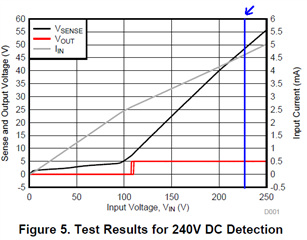Hi Team,
For ISO1211 AC detection design, is the output level a steady state DC signal?

This thread has been locked.
If you have a related question, please click the "Ask a related question" button in the top right corner. The newly created question will be automatically linked to this question.
Hi Team,
For ISO1211 AC detection design, is the output level a steady state DC signal?

Hi Kevin,
Thank you for reaching out.
If you apply a sinusoidal waveform at the bridge rectifier input, ISO1211 gets triggered at its VIL and VIH input thresholds and produces a rectangular waveform at the output. Hence, you will see rectangular waveform in sync with the sinusoidal waveform. Let us know if anything is not clear, thanks.
Regards,
Koteshwar Rao
Hi Koteshwar Rao ,
Thank you for your kind support,
Actually,We use ISO1211 for AC 220V detect function in our product design ,
and we refer circuit as below :

Q1 : If we want the ISO1211 output is stable DC voltage level , could I adjust Cin cap value ?
Q2 : What's point A's voltage level ?
Thanks a lot.
Hi Rick,
Thank you for sharing additional details of your requirement.

Regards,
Koteshwar Rao
Hi Koteshwar Rao ,
Thank you for quick reply and suggestion ,about this bulk cap ,I have two question need make sure :
Q1. The capacitor rated voltage:
In refer circuit ,the input AC 220V to bridge rectifier output to DC voltage level ,
below chart's blue line is maybe in DC 220V input voltage ,
The Vsense voltage is 50V ,so could I make sure the bulk voltage is 50V above ?
and ,In our current design ,the CIN (C420) is 100V ,is it enougth ?

Q2. The capacitor type :
Could I select MLCC for this bulk cap?
Thank you for your great support.
Hi Rick,
Thank you for seeking additional clarification. Please find my inputs below, thanks.
Regards,
Koteshwar Rao